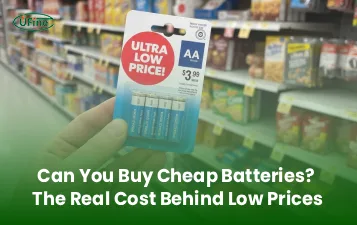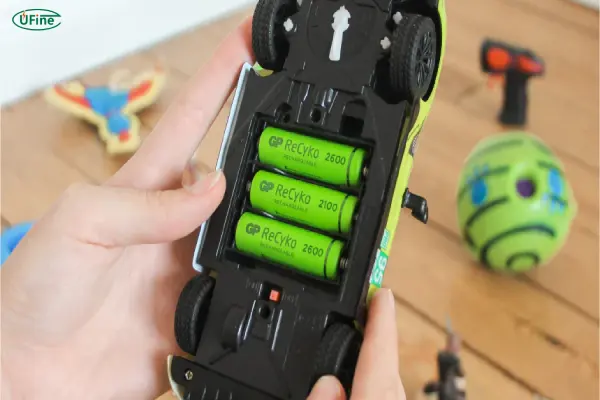
- Part 1. How does a toy car battery affect the performance of a toy car?
- Part 2. Types of toy car batteries
- Part 3. How many volts is a toy car battery?
- Part 4. How long can a toy car battery last?
- Part 5. Key features to look for in a good toy car battery
- Part 6. Toy car battery price
- Part 7. How to charge toy car battery?
- Part 8. Toy car battery charger
- Part 9. Toy car battery replacement
- Part 10. Final thoughts
- Part 11. FAQs
Part 1. How does a toy car battery affect the performance of a toy car?
The toy car battery is the heart of every ride-on toy or remote control car. Without a good battery, the car won’t move fast, go far, or run for long. The power, speed, and smoothness of the ride are all directly connected to the battery.
If you use a weak or low-quality battery, your toy car may struggle to climb, move slowly, or stop suddenly. On the other hand, a strong and reliable toy car battery ensures smooth acceleration, better control, and longer playtime. So yes, the battery truly makes a big difference in performance.
Part 2. Types of toy car batteries
There are several types of toy car batteries, and each has its own pros and cons. The most common types include:
1. Lead-Acid Batteries
These are affordable and commonly used in big ride-on cars. They’re bulky but provide steady power. However, they are heavy and take longer to charge.
2. Nickel-Cadmium (NiCd) Batteries
An older type used in small RC cars. They’re cheap but suffer from “memory effect,” which can reduce their life over time.
3. Nickel-Metal Hydride (NiMH) Batteries
More modern than NiCd. They have longer life, more power, and no memory effect. They’re a good option for mid-range toy cars.
4. Lithium-ion (Li-ion) Batteries
These are lighter, charge faster, and last longer. They’re often used in premium toy cars. However, they can be more expensive.
5. Lithium Polymer (LiPo) Batteries
LiPo batteries are the most powerful and lightweight option. They’re perfect for high-performance RC toy cars. But they must be handled carefully to avoid overheating or damage.
So depending on your toy car model, you may need one of these battery types.
Part 3. How many volts is a toy car battery?
The voltage of a toy car battery depends on the size and power of the toy. Here’s a quick breakdown:
- 6V battery – For small toy cars, toddlers, or indoor use. Speeds around 2–3 mph.
- 12V battery – Most common for average ride-on cars. Speeds between 4–5 mph.
- 24V battery – Used in more powerful, larger ride-on cars. Speeds up to 6–7 mph.
- 36V/48V battery – Found in advanced models or electric dirt bikes for kids.
Always match the battery voltage with your toy car’s motor and design. Using a battery with the wrong voltage can damage the car or reduce performance.
Part 4. How long can a toy car battery last?
There are two ways to look at this: playtime per charge and battery lifespan.
Playtime Per Charge:
- 6V battery – 30 to 45 minutes
- 12V battery – 1 to 2 hours
- 24V battery – 2 to 3 hours
This depends on terrain, child weight, battery age, and how the car is driven. Faster speeds or rough surfaces will drain the battery quicker.
Battery Lifespan:
A typical toy car battery can last:
- Lead-acid batteries – 1 to 2 years
- NiMH/NiCd batteries – Around 500 charge cycles
- Lithium-ion/LiPo batteries – 2 to 3 years or 800+ charge cycles
Proper charging and storage help extend battery life.
Part 5. Key features to look for in a good toy car battery
Choosing the right toy car battery can make a big difference. Here are the top features to consider:
- Voltage – Match the battery voltage with the car’s motor system.
- Capacity (Ah) – Higher capacity = longer playtime.
- Battery Type – Choose based on budget, performance, and safety.
- Recharge Time – Shorter charge times mean less waiting.
- Cycle Life – More charge cycles = longer battery lifespan.
- Safety Features – Look for overcharge protection, temperature sensors, etc.
- Brand & Quality – A trusted brand usually means better quality and support.
If you’re unsure, it’s better to choose a battery from a reputable supplier like Ufine Battery, a well-known custom battery manufacturer offering safe and long-lasting options.
Contact Ufine Battery for custom battery replacements that fit your toy car perfectly.
Part 6. Toy car battery price
Prices can vary depending on battery type, brand, and capacity:
- 6V Lead-acid: $15 – $30
- 12V Lead-acid: $25 – $50
- 24V Lead-acid: $50 – $80
- Li-ion or LiPo batteries: $30 – $120+
While lithium batteries may seem more expensive, they often provide better performance, faster charging, and longer life, making them cost-effective in the long run.
Part 7. How to charge toy car battery?
Charging your toy car battery the right way keeps it healthy and lasts longer. Here’s how:
- Check the user manual – It tells you how long to charge and what charger to use.
- Turn off the car – Never charge the battery with the toy switched on.
- Connect the charger – Plug it into the battery and wall outlet.
- Charge for the recommended time – Don’t leave it charging too long.
- Monitor it occasionally – Make sure it doesn’t overheat.
- Unplug when full – Avoid overcharging to prevent damage.
Tip: Charge the battery after every use, especially if it’s below 50%.
Part 8. Toy car battery charger
Every toy car battery charger is different, and using the wrong one can cause serious issues. Here’s what to look for:
- Correct Voltage Output – Match the battery (6V, 12V, 24V).
- Current Rating – Higher amps = faster charging, but don’t overdo it.
- Automatic Shutoff – Prevents overcharging.
- Compatibility – Some batteries require specific connectors or charge profiles.
- Smart Features – Modern chargers may include battery health checks.
Part 9. Toy car battery replacement
Sooner or later, every toy car battery needs replacement. Here’s how to know it’s time:
- Car doesn’t run as long as it used to
- Car runs slower or struggles to start
- Battery takes forever to charge
- Charger light never turns green
- Battery is swollen or leaking
To replace the battery:
- Remove the old one – Safely disconnect the wires.
- Buy a compatible replacement – Same voltage and connector.
- Install the new one – Secure connections and test the car.
- Recycle the old battery properly – Never throw it in the trash.
Part 10. Final thoughts
A good toy car battery means longer playtime, better speed, and happy kids. From understanding battery types to learning how to charge, replace, and choose the right one—it all matters.
Whether you’re buying a new battery, replacing an old one, or just curious about how they work, this guide has you covered. And if you ever need help with finding the best battery or charger, don’t hesitate to reach out to Ufine Battery.
We’re a trusted Chinese battery manufacturer offering customized lithium and toy car battery solutions for all your needs. Safe, reliable, and built to last.
Contact Ufine Battery today to find the perfect toy car battery for your little driver.
Part 11. FAQs
Can I upgrade my toy car battery to a higher voltage?
Not always. Higher voltage can damage the motor or electronics. Only upgrade if the toy car supports it.
How long should I charge my toy car battery?
Usually between 6 to 12 hours, depending on the battery type. Follow your manual for exact charging time.
Can I use a different charger for my toy car battery?
Only if it matches the voltage and connector. Using the wrong charger can damage the battery or cause safety issues.
Why is my toy car battery dying so fast?
It could be old, overcharged, undercharged, or used on rough terrain too often. Also check for electrical problems in the car.
Where can I buy a new toy car battery?
You can find batteries online, in stores, or from manufacturers like Ufine Battery, which offers high-quality and customizable options.
Related Tags:
More Articles

Can You Really Buy Cheap Batteries Safely?
Learn the truth about cheap batteries, hidden risks, and how to find affordable yet safe lithium batteries from Ufine Battery experts.
Do Lithium Batteries Require Special Strap Downs? (Safety + Vibration Control)
Discover why lithium batteries require special strap downs to prevent vibration damage, terminal stress, and internal component issues.
Battery Strap Down Safety Tips: Preventing Vibration Damage and Terminal Stress
Follow these expert battery strap down safety tips to prevent vibration damage, terminal stress, and ensure LiFePO4 battery longevity.
How to Choose a Good 18650 Battery with Reliable Quality?
Battery quality defines performance and safety. Ufine Battery shares how to source good 18650 batteries and avoid unstable suppliers.
Can I Use a Universal Battery Strap Down on LiFePO4 Batteries? (Compatibility Guide)
Learn whether universal battery strap downs are compatible with LiFePO4 batteries, and how to install them safely for vibration control.




